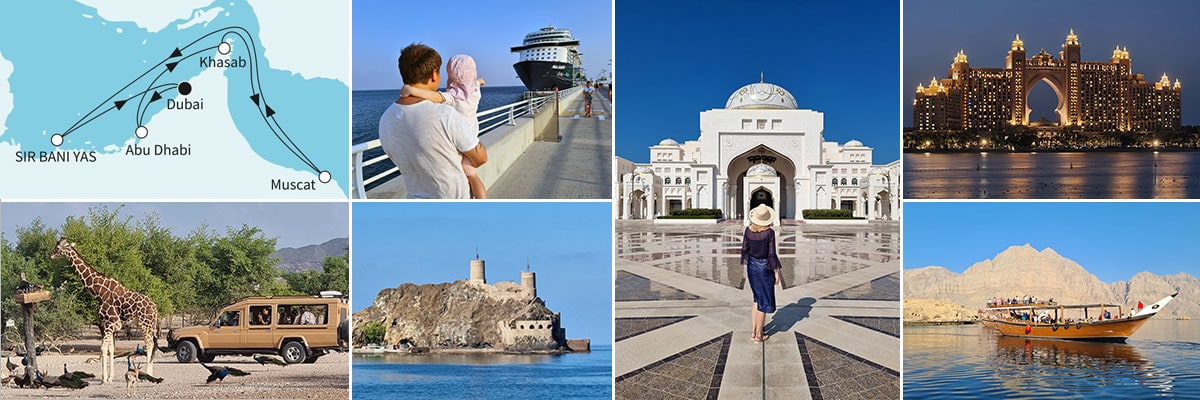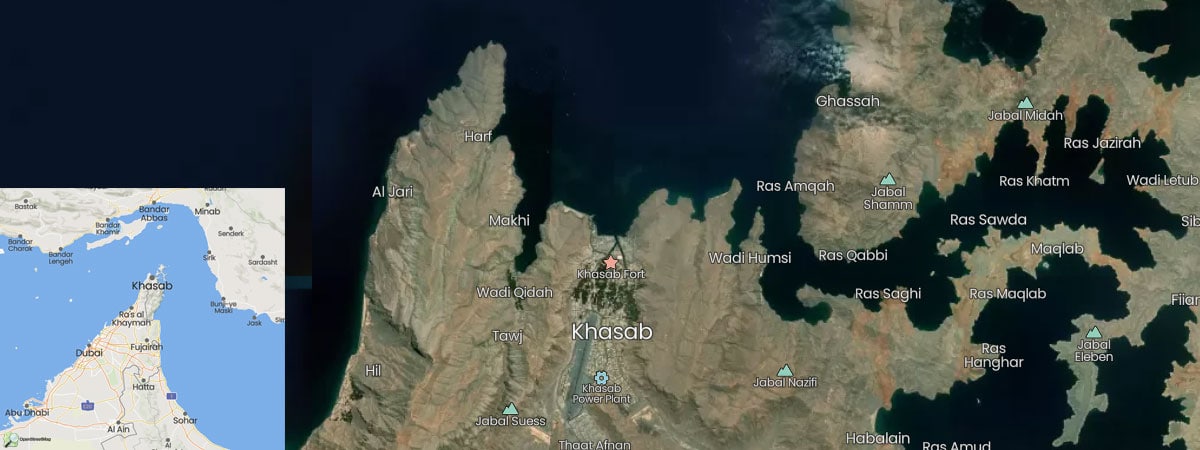After exploring the metropolitan city of Abu Dhabi the day before, we arrived with our cruise ship Mein Schiff 6 in the early morning in the port city of Khasab. This is located on the Musandam peninsula in the north of Oman and awaited us with a breathtaking fjord landscape. We spent a wonderful day on the water here and even had some animal companions.

Table of contents
Things to know about Khasab (Oman)
Khasab is a small port city in Oman with a population of about 17,000. It is located on the Musandam Peninsula on the Strait of Hormuz, a strait only a few nautical miles wide that connects the Persian Gulf in the west with the Gulf of Oman, the Arabian Sea and the Indian Ocean in the east.
The area around Khasab is an exclave of Oman and an enclave in the territory of the United Arab Emirates. This means that the region is physically separated from the rest of Oman by borders and can only be reached through the territory of the United Arab Emirates. Dubai is just under 200 kilometers from Khasab, while the Omani capital Muscat is about 540 kilometers away.
A shore excursion in Khasab focuses on nature and culture. The picturesque fjord landscape and the spectacular mountains of the Hajar Range invite you to boat trips and jeep safari tours. With the restored 17th century Khasab Fort and its local history museum, you can delve a little deeper into the history of the region.
Cruise ship docking & our mooring time
Berth Khasab: Passenger Terminal No. 1
Laytime: 7 a.m. to 6 p.m.
All aboard: 17.30
In Khasab we docked at the local port, which is a very manageable size. There is a small terminal building on the site that houses a gift store, security screening, and a waiting area for tour/taxi providers. There is no extensive tourist infrastructure here.
A boat trip through the fjord landscape of Khasab
To get to know the area around Khasab a little better, we opted for the approx. four-hour excursion “Traditional boat trip through the fjord world” (OMKHS002) via Mein Schiff, which cost 68 EUR per person.
The meeting point was 7:45 a.m. right at the small harbor, which was only about a 5-minute walk from where we docked. During our walk we already noticed that the excursion is probably the most popular excursion among the cruise guests, because the passengers flocked to the jetty in rows, so that a small queue also formed in front of the excursion boats. However, our fear that the boats will be accordingly very full was not confirmed. There were enough boats so that the passengers could spread out super. On board there were simple toilets. Fruit (bananas, oranges, dates) and drinks (soft drinks, water, coffee, tea) are included in the price.
Shortly after 8 o’clock we left on a traditional wooden dhow. We all sat on thick seat cushions on the floor, which was super cozy. There was also a sun deck on the upper deck. The sun already had decent radiance, so the temperatures were already very pleasant. As we left the harbor, we had a beautiful view of our cruise ship before we turned into the fjord.
The Omani fjords
The fjord ‘Khor Ash Sham‘ is with 16 km the longest fjord in the Arabian area, therefore the fjord landscape here is often called the “Norway of Arabia“. No wonder, because here, directly after entering the fjord, the craggy, steep rock faces tower up on the right and left hand side, creating a breathtaking panorama.
Our local tour guide kept giving us (English) information about the fjord and the area during the trip. A TUI Cruises employee was also there and then translated his information into German.
Snorkel stop at Telegraph Island
On the right side of the fjord we could already see a small fishing village from a distance. It is one of five villages in the fjord, all accessible only from the water. There is no connection by land and also no drinking water pipeline. Therefore, the residents are supplied with drinking water weekly by the Omani government.
Next we arrived at Telegraph Island. Here the English built a telegraph cable repeater station in 1864, which was then part of the connection from London to India. It was in operation for only a few years due to unexpected problems (including heat). Today, only the foundation walls of this station can be seen on the island.
Our boat dropped anchor just off Telegraph Island for a 30-minute swim and snorkel stop. Our guide gave us the hint that the water here is very salty and can be itchy on the body. Therefore, we decided not to go into the water with our daughter. During the time we watched the many fish that swam around our ship and enjoyed the picturesque surroundings.
Dolphins in the fjord
During our trip through the fjord we could watch dolphins again and again, which accompanied us a part of the way and played in the waves of our boat. We knew from the description of the excursion that the chances of seeing dolphins were good, but then of course we were overjoyed to have actually seen some. This was definitely a highlight of our trip.
Khor Ash Sham Fjord & Smuggler
After we reached the end of the fjord after 16 km boat ride, we slowly started our way back. Also on the return trip we could see again some dolphins and let the picturesque scenery of the fjord world work on us once more.
As we left the Khor Ash Sham fjord, we immediately noticed the countless packed speedboats that raced past our boat and headed out to the open sea. Some of the men on the boats were hooded, so we were overcome with a queasy feeling. But our tour guide then clarified the situation very quickly and gave us some interesting information about this.
The men on the boats are Persian smugglers who arrive daily in the early morning hours from nearby Iran to Khasab, Oman, to trade carpets, sheep, goats and cash for Western merchandise. The smugglers are very interested in consumer electronics (especially iPhones), but spare parts for cars and cigarettes are also in high demand – in other words, everything that Iranian citizens can hardly or not at all get legally. Packed full of goods, the men then return to Iran after a few hours. The goods are hidden under gray tarpaulins; the men have masked their faces to protect themselves from the sun and the water. Our guide told us that trading was legal in Oman (goods are also officially cleared according to Omani tariffs), but the way back to Iran could be difficult, because smuggling is forbidden there. That is why the coast guard permanently patrols the waters off Iran – always on the hunt for the smugglers.
And for Khasab itself, of course, the Iran sanctions and the smuggling that goes along with them are a blessing, because trade and the economy flourish as a result. On some days, up to 300 Iranian boats dock in the small port city. Many people have become very rich as a result. A total contrast to the once isolated coastal village, which was still a restricted area for the Omani military until the early 1990s.
Around 12 o’clock we arrived back at the port of Khasab and first had a little lunch and dinner break on the ship before our sightseeing program continued in the afternoon.
A visit to Khasab Castle
In the afternoon we walked from the port to the city. It took us about 20 to 25 minutes to walk the approximately two kilometer path, which runs directly along a busy road.
Our destination was Khasab Fort, which was once located right on the shore and was moved a bit inland after the modern port was built. The fortress is very well preserved and is one of the most beautiful fortresses in Oman with its numerous exhibits illustrating many aspects of ancient Oman. At the entrance there is a small ticket office where you have to pay 500 Omani Baisas (half an Omani Rial) per person as entrance fee – that is about 1,25 EUR.
When we arrived, several people had just left again from a Mein Schiff bicycle tour, so we were completely alone in the fortress. Only later did a few other tourists join us.
The well-preserved fort was built by the Portuguese in the 17th century around a much older round tower. Today the castle is characterized by a round and hollow main tower inside and a square outer part with other stone towers. The fortress was once used by the locals as an army base and later as the seat of the Wali of Khasab and a city prison.
After extensive restoration, it now houses a small museum of local history and heritage, displaying numerous craft and archaeological collections related to the history of the Musandam Peninsula. The living quarters in the castle were also renovated and turned into a furnished house. Here there are many rooms where colorful carpets, jewelry, robes, weapons, kitchen utensils, wedding equipment and a Koranic school are exhibited.
For the tour of the fortress we took about 45 to 60 minutes to look at all the rooms and towers at our leisure. After that we walked back to the ship where we spent the rest of the afternoon at the pool.
All travel reports of our cruise with Mein Schiff
On our one-week cruise "Dubai to Oman" with the Mein Schiff 6 from TUI Cruises, we were able to experience five eventful and varied days ashore: Our journey took us from the city of superlatives - Dubai - to Abu Dhabi, where the largest mosque in the United Arab Emirates is located. We continued to the oriental Khasab (Oman) with its breathtaking fjord landscape and to Muscat, the capital of the Sultanate of Oman, which is surrounded by mountains and desert. The last stop of our trip was after a relaxing sea day the island Sir Bani Yas (UAE), which offers a kilometer-long sandy beach and a nature reserve with 10,000 animals. With beautiful memories in our luggage, disembarkation then took place back in Dubai. Crusie Day 1 » Mein Schiff 6 - Check In, Cabin & Discover the Cruise Ship
Crusie Day 1 » Mein Schiff 6 - Check In, Cabin & Discover the Cruise ShipCrusie Day 2 » Abu Dhabi - The Top 5 Sights on Your Own
Crusie Day 3 » Khasab - Boat trip through the fjord world & Khasab Castle
Crusie Day 4 » Muscat - Top 5 Sights & Photo Spots
Crusie Day 5 » Seetag
Crusie Day 6 » Sir Bani Yas (Beach, Safari & Island Tour)
Crusie Day 7 » Dubai (Day on board & Check Out)

